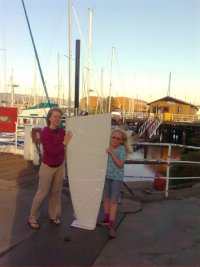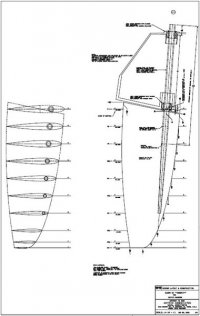Do you have any info on better rudder designs
for the Olson 34 like possibly that on "Rasberry"
that you mentioned sometime back. I notice Elaine's (ewade)
blog under Design & Function, Olson 34 Reno, projects
that she found someone in Vancouver to build them a new rudder.
She is claiming hers is cavitating and boat rounds up in heavy air.
Wondering what design she is using?
Our Olson 34 even with the shorter rig has a tendency to round up
has a lot of rudder angle most of the time and the rudder seems to "stall out."
Under heavy air we use the No. 3 Genoa, North 3dl, and full flat main. Reefing
the main has not worked too well for our speed.
I tried a longer toggle on the backstay and took up accordingly on the forestay
to pull the mast forward. Result was forward bend in the top tapered section of the mast
as the mast was completely forward in the partners. We took out the backstay
toggle so the mast would be at least straight with no extra backstay pumped up.
We still seem to have excessive weather helm.
Also have a very technical tuning question.
I have a shorter rig since my Olson is an early one
from the Alameda area. Do we probably have the Kenyon 4270HP Mast Section?
To rake my mast forward I need either one or both of 2 things:
I could use the Mast Step Base Plate Adapter No. K-11824 from RigRite.
Or carve some fiberglas out of the forward partner area in the top deck.
Can you estimate the maximum a mast should be raked forward
for a weather helm problem?
If the plate will fit through the floor panel without too much carving it would
have another important benefit. It would raise the mast 3/8 inch higher
to allow for more turnbuckle adjustment. My shrouds are probably stretched
out somewhat, and the turnbuckles need more travel.
Any expertise you could provide on mast tuning would be greatly appreciated.
Steve Jones
Olson 34
Edgewalker
Longview, WA 98632
for the Olson 34 like possibly that on "Rasberry"
that you mentioned sometime back. I notice Elaine's (ewade)
blog under Design & Function, Olson 34 Reno, projects
that she found someone in Vancouver to build them a new rudder.
She is claiming hers is cavitating and boat rounds up in heavy air.
Wondering what design she is using?
Our Olson 34 even with the shorter rig has a tendency to round up
has a lot of rudder angle most of the time and the rudder seems to "stall out."
Under heavy air we use the No. 3 Genoa, North 3dl, and full flat main. Reefing
the main has not worked too well for our speed.
I tried a longer toggle on the backstay and took up accordingly on the forestay
to pull the mast forward. Result was forward bend in the top tapered section of the mast
as the mast was completely forward in the partners. We took out the backstay
toggle so the mast would be at least straight with no extra backstay pumped up.
We still seem to have excessive weather helm.
Also have a very technical tuning question.
I have a shorter rig since my Olson is an early one
from the Alameda area. Do we probably have the Kenyon 4270HP Mast Section?
To rake my mast forward I need either one or both of 2 things:
I could use the Mast Step Base Plate Adapter No. K-11824 from RigRite.
Or carve some fiberglas out of the forward partner area in the top deck.
Can you estimate the maximum a mast should be raked forward
for a weather helm problem?
If the plate will fit through the floor panel without too much carving it would
have another important benefit. It would raise the mast 3/8 inch higher
to allow for more turnbuckle adjustment. My shrouds are probably stretched
out somewhat, and the turnbuckles need more travel.
Any expertise you could provide on mast tuning would be greatly appreciated.
Steve Jones
Olson 34
Edgewalker
Longview, WA 98632




